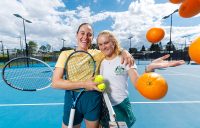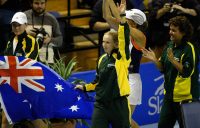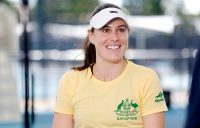Melbourne VIC, Australia, 14 May 2015 | Australian Tennis Magazine
Early gains are always a reliable measure of a potential champion. But it’s how they deal with adversity that often proves the real measure of how far a young player will progress in their professional career.
For Russian-born Melburnian Daria Gavrilova, there has been no shortage of either of those qualities. The US Open girls’ champion and year-end world No.1 junior in 2010, Gavrilova’s positive momentum ended abruptly when she suffered a devastating knee injury while competing in Taiipei late in 2013. A torn ACL meant surgery and the best part of a year recovering on the sidelines. “I was just heartbroken when they said I would be out for nine months,” she recalled.
For some players, that time away from tennis at such a critical time in her career might have been an insurmountable hurdle; “Dasha” as she is known to those closest to her, only became more passionate about thriving in the sport she’d first discovered with her parents, Alexey and Natalia, as a six-year-old in Moscow.
“I kind of had to stop and think,” Gavrilova told Australian Tennis Magazine as she prepared to leave Australia and contest WTA qualifying events in Doha, Indian Wells and Miami. “As much as I didn’t want it, this pause was really what I needed … the way it happened is not the perfect way (but) I think it helped me a lot.”
With time to work on the physical aspects of her game – her forehand, long Gavrilova’s most notable feature, is now backed by a better backhand and a more reliable serve – the 21-year-old also found an extra edge in the mentality that was already considered a key point.
“I really appreciate it way more,” Gavrilova explains, pointing to the value she places on being able to compete at such a high level. “I was kind of just playing tournaments and now I’m really enjoying it, ‘cause you don’t want to be there waiting to get healthy. You just want to be out there playing.”
And not just playing, but claiming some big wins too. Gavrilova made the most significant statement of her young career as she outclassed world No.2 Maria Sharapova 7-6(4) 6-3 in the second round of Miami, in what many described as the biggest upset of the season so far.
“I have been dreaming about beating Maria since I was probably 12 (years old) when I saw her win Wimbledon, when she beat Serena,” she said. “I mean, she was my idol. She’s obviously Russian. She’s just huge in Russia.”
While Gavrilova herself was understandably stunned immediately after upsetting the five-time Grand Slam champion, those closest to her were hardly surprised. Buoyed by gaining a wildcard through victory in the Australian Open Play-off last December, she’s been on an upper trajectory all season, claiming notable wins over Alison Riske in Brisbane and Belinda Bencic in Sydney, with consecutive Pro Tour victories in Burnie and Launceston adding priceless confidence as she qualified for the three WTA events she targeted in February and March.
Six weeks after that Miami breakthrough, Gavrilova proved it was no fluke when she scored her second top 10 scalp; this time, it was No.7 seed Ana Ivanovic on the receiving end as Gavrilova upset the former world No.1 in the second round of Rome. Again, she had come through qualifying.
Coach Nicole Pratt explains that many weapons have contributed to those successes. “Daria is an exceptional mover out on court and her defensive skills are excellent,” Pratt noted. “She has ability to win free point off her forehand and serve and her backhand is very solid so there are no real weaknesses that opponents can attack. She is also extremely competitive and hates to lose.”
Early 2015 success is also a positive sign of Gavrilova’s life-changing move from Russia to Melbourne, where she trains with Pratt and others at the National Tennis Centre. While still officially listed as Russian in the WTA rankings – which will change when she gains an Australian passport, hopefully later this year – Gavrilova is thrilled to represent Australia in Grand Slam events.
“It’s so good living here in Melbourne. I just love it,” she enthused. “I just love how easy it is to get to everything and obviously training at the place where you play the Australian Open. Everybody is coming here for a Grand Slam and I get to train here. It’s just amazing. The people are lovely. It’s a very sporty city and I think it suits my lifestyle.”
It helps to have such a strong support network, with Gavrilova in a long-term relationship with Luke Saville after the pair met at the Junior Davis and Fed Cup in 2010. Other Australian players are equally welcoming. “All the girls are really nice,” she said. “I can’t wait to be in the Fed Cup (team). I hear a lot of stories and they’re having a lot of fun. We all support each other, so I’m looking forward to it.”
There’s also a growing fan base, Dasha heartened by the support she received as she competed in Brisbane earlier this year. “Just feeling Australian and feeling like everyone is supporting me, it’s very great. It’s nice,” she said.
The international audience were equally responsive when she thrilled them with her high-energy style as she overcame Sharapova. “I was actually surprised how many people knew my nickname. A few people were saying, ‘Yeah, Come on, Dasha. Let’s go. You can do it’,” she related. “It was an amazing feeling. It was actually pretty crowded. Like it was packed. I was overwhelmed.”
At the same time, the 10th-youngest member of the WTA’s top 100 can clearly take the credit for making such an impressive name for herself. While thrilled with comparisons to childhood idols Kim Clijsters and Martina Hingis, Gavrilova is clearly forging her own path.
“They’re both very talented. For me they were my idols and I really wanted to play like them since I was little. Now I think I’m doing something similar to Kim and I have some similarities to Martina. Obviously I need to work a lot on that but I don’t want to be just like them. I have to be myself,” she pointed out.
It’s a wise approach given the gains of 2015. Having started the season at world No.233, Gavrilova peaked at a career-high ranking of No.76 in early April – and considering she has virtually no points to defend in the coming months, that’s likely to be just the start for one of the most talented young players in the women’s game.
“I definitely think Dasha is one of the up and coming players everyone out on tour is watching. She has been consistent with her results this year and a win over Sharapova proves that she is a dangerous player in every main draw she competes in,” says Pratt.
“This will be the first year that she will have played all four Grand slams so its also about gaining experience, learning how to go deep into tournaments, and continued body management … It’s exciting to know she has no points to defend until September so her ranking is going to continue to rise.”
While Gavrilova herself “doesn’t like putting a number on goals” there’s justifiable optimism about the future. Having progressed from dreaming about her idols to actually defeating them, few would be surprised to see the likeable young player emulating her top junior results at a higher level.






